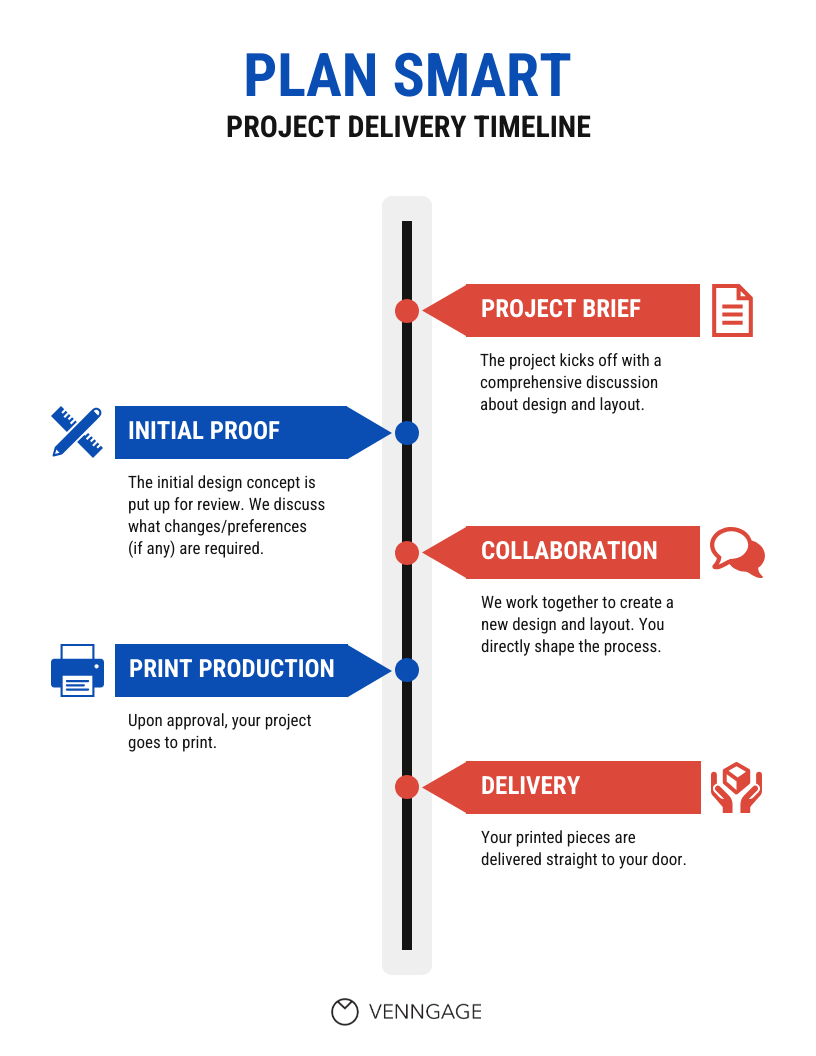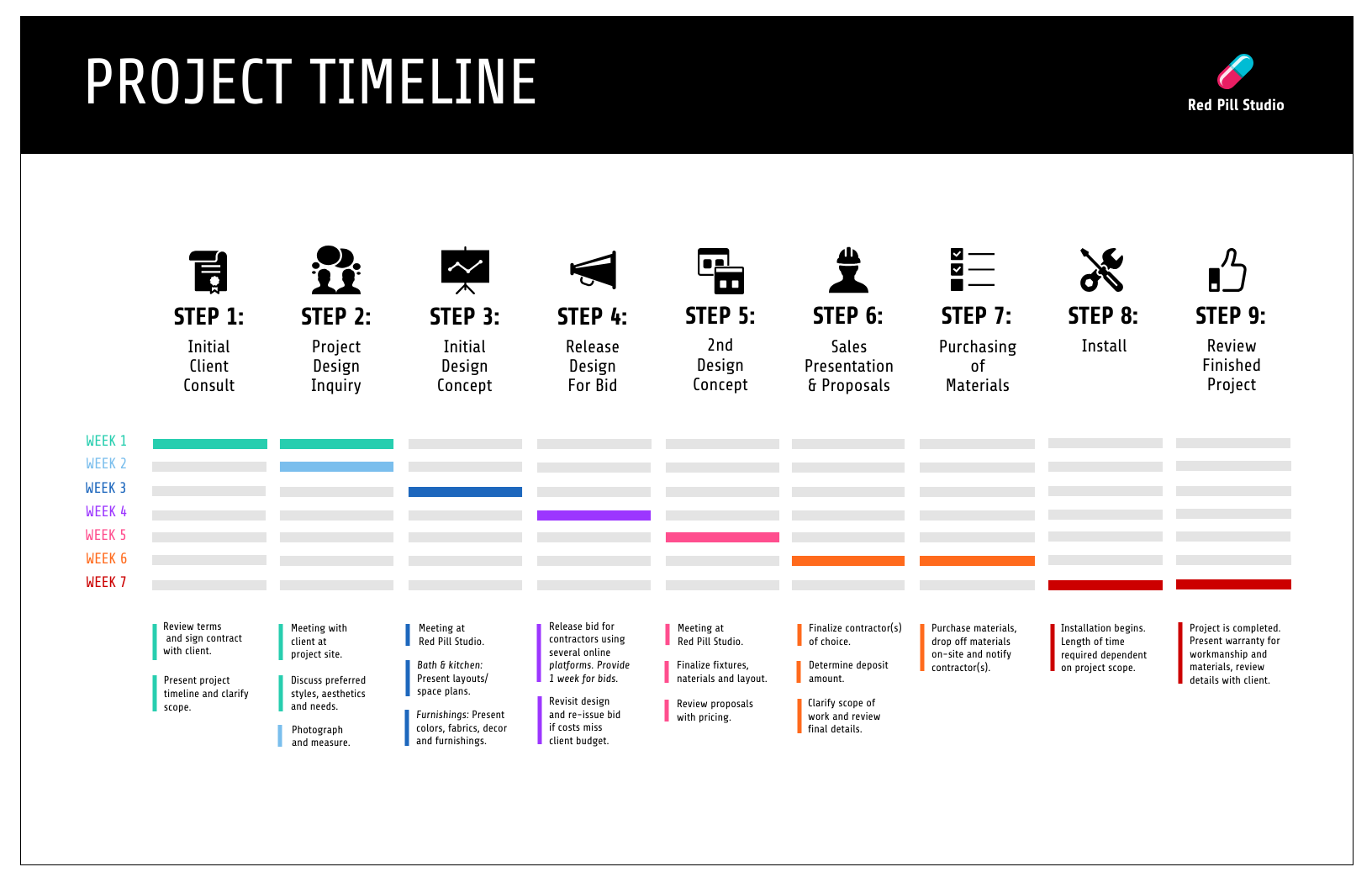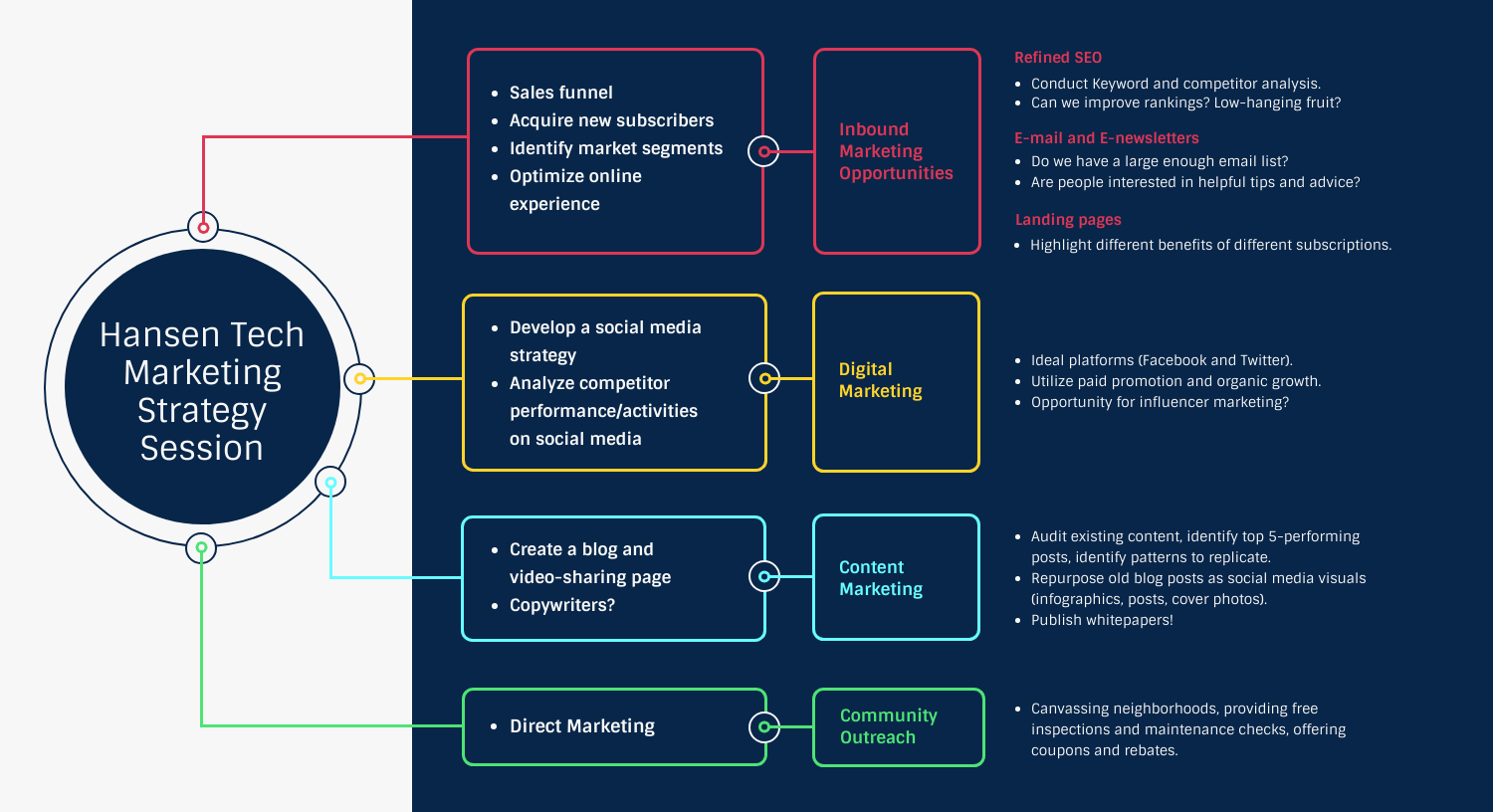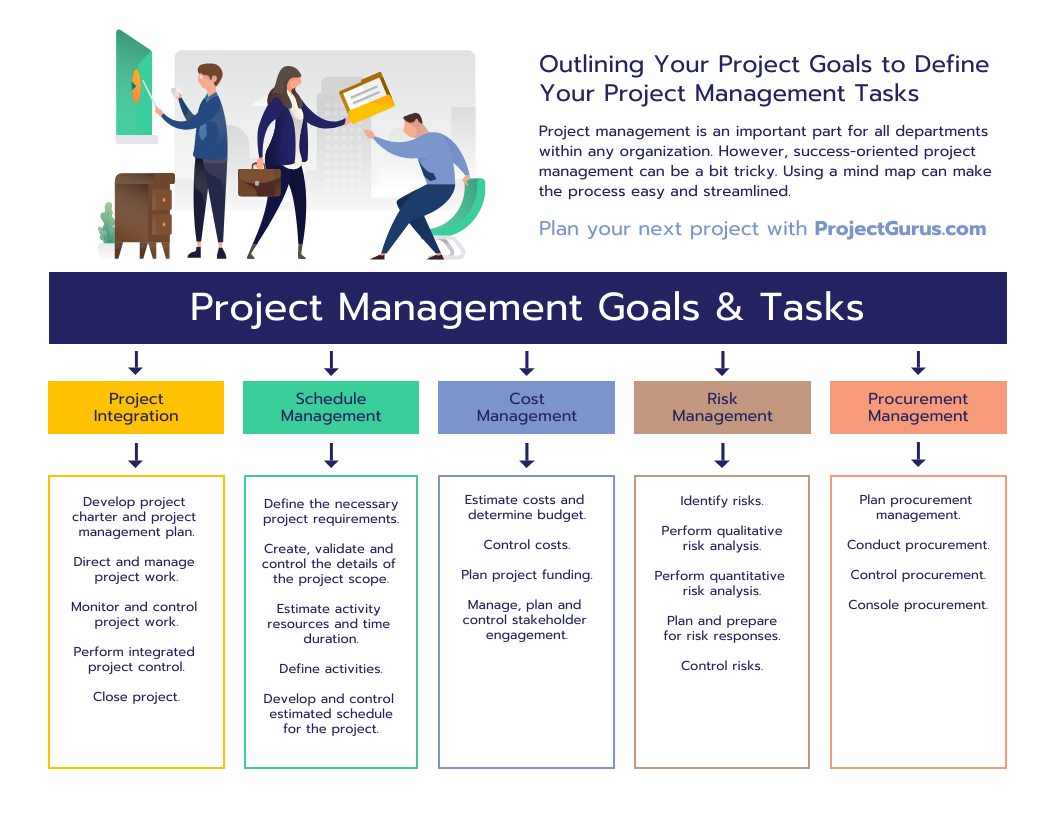
If you’re a project manager, juggling tasks and people is your bread and butter.
It may seem tough but someone’s got to have a plan of action with clear goals and methods to track progress. Do we really want more conflict and tension between managers, employees, and clients?
But there’s a lot more to project plans than goal setting.
Project plans must also include an action plan that assigns responsibility, set clear timelines, and define the line of communication plan (and more) to ensure everything goes smoothly from start to finish.
In this blog, I’ll show you how to develop robust project plans (using a Gantt Chart Maker or project plan templates) that drive success.
Click to jump ahead:
- What is a project plan
- Why project plans are important
- Key components of a project plan
- How to create a project plan
- Phases of a project life cycle
- Example project plan
- Project plan templates
- Conclusion
What is a project plan?
A project plan is a document that outlines the goals, objectives and task of a project. It also includes additional details such as project schedule, scope, due date, and deliverables.
The main use cases of a project plan include:
- Define what needs to be done and by when
- Define roles and responsibilities
- Facilitate communication
Here’s an example project plan:

Why are project plans important?
Project plans are important because they tell teams who is responsible for what and when to execute, from day one until project completion.
Let’s explore the importance of project plans in detail.
Provide a common vision to all parties
Project plans let you describe a vision which helps prevent confusion and team members working at odds.
Essentially, they keep everyone “on the same page” and help teams work together to achieve a common goal.
This project plan template is a great example of how you can define your project and set clear goals and objectives from the start.
Allow you to minimize risks (risk management)
Risk management is a critical component of project management as it allows you to identify potential threats and take preventive action to keep projects on track. Understanding KYB requirements is equally essential for businesses to mitigate risks associated with onboarding new clients and partners.
Project plans should include periodic project status reports like in this example below to monitor progress and identify emerging risks.
Make sure resources are allocated appropriately
Resource allocation is the strategic process of assigning the right people, tools, and budget to tasks throughout the project life cycle.
With project plans, you’ll be better able to allocate resources to areas where they are needed most.
This project project plan breaks the project into distinct stages so that you can map out resource requirements ahead of time.
Let you define a clear project scope
The project scope defines the boundaries of a project and informs you on what tasks and activities to expect.
This information is critical when it comes to complete projects on time, not go over the set budget, and deliver acceptable quality.
Improve both internal and external communication
Good communication is central to success no matter the type or size of your project.
Project managers must lay out how communication occurs whether the project includes two employees or hundreds spanning multiple teams and time zones. Creative project management software can help streamline communication processes and ensure efficient collaboration among team members.
Will communication be through email, virtual meetings, shared documents, or live chat through tools like Slack? Or a combination of all? Project plans should answer this question.
Here’s a great example of a project communication plan which clearly informs team members on what communication method to use in different situations.
Allow you to set clear milestones
Setting milestones for each phase of a project project helps you evaluate overall progress and identify and address potential roadblocks ahead of time.
A great way to set clear milestone is to visualize them for easy tracking using a Gantt chart.
Allow you to be flexible and make changes quickly
Change is an unavoidable aspect or projects. Once your team starts working, it’d be a miracle if you’re able to avoid snags that affects scope, timeline, and overall success.
That’s why project plans not only make you to set goals but also mandate frequent status reports sections so that you can detect issues and adapt before something becomes a big problem.
Give you the ability to create high-level project schedules
Project plans have a wide use case, including being a tool to inform people outside your organization (investors for example).
In these cases, project schedules can provide a high-level and more accessible overview of what the project hopes to accomplish and by when.
What does a project plan typically include?
A project plan has many moving parts but generally they include information about the project scope, schedule, deliverables, and due dates for each phase of a project.
Information on project phases
Project plans usually break projects into smaller manageable stages, with each phase having specific goals and deliverables (I’ll go through this later down in the blog…so keep reading!)
Detailed description of activities, tasks, and deliverables
Project plans include detailed information on what needs to be done at the granular level as well as at the high-level. Generally, we can classify this information as follows:
- Activities are the broad categories of work that needs to be done (think of them as the chapters of your project story).
- Tasks are the specific actionable steps that make up each activity (aka the sentences within each chapter).
- Deliverables are the outputs produced at the end of each phase.
Task start and end dates
Project plans would be pretty useless if they didn’t tell you when certain tasks or activities should be completed.
Although project plans with set start and end dates are most effective, you don’t always need to be that specific (often a range of a few days or a week is equally effective).

Task dependencies
Task dependencies refers to figuring out relationships between tasks as this can influence the project timeline.
For example, for a website launch to happen, developers can’t start coding (dependent on) until designers provide the final website layout.
This is where Gantt charts really shine since you can use them to visualize concurrent timelines on one chart which makes it easy to spot task dependencies.
There are several types of task dependencies to keep in mind:
- Finish-to-start (one task must finish before another can begin)
- Start-to-start (both tasks can begin at the same time)
Clear milestones and baselines
Milestones and a baseline give project managers a way to measure actual project performance against expectations.
- Baseline: Refers to an approved project plan at a specific time point, and includes information on schedule budget, schedule, and resource allocation.
- Milestones: Represents completion of major project stages or deliverables.
Both elements allow project managers to course-correct if needed to keep the project on track for success.
An informative project scope statement
The project scope statement defines the boundaries of your project.
It’s usually a single statement that encapsulates everything you need to know about a project, from specific goals, tasks, deliverables, costs, and timelines to be followed.
Here’s an example:
“To renovate the community park spending no more than $500,000 and to provide modern recreational facilities, enhanced green spaces, and improved accessibility while ensuring environmental sustainability by year-end”
List of requirements
Project plans should include a list of all requirements that must be met before any work begins.
Depending on the type of project, you might include technical requirements, functional requirements, non-functional requirements, or other kinds of requirements.
Methods to assess risk
All good project plans include an analysis of factors that can negatively impact the goal, timeline, or results of a project.
The logic is that ideally you should be able to nip problems in the bud before they derail a project entirely.

How to create a project plan in 10 simple steps
Creating project plans can seem daunting at first since there’s so many things to cover. The best advice I can give you though is to break the project planning process down into distinct steps.
Some important things to consider when creating a project plan include:
- Set clear goals
- Create a list of tasks
- Set a timeline
- Sett a budget
- Have a communication plan
Let’s look at how you can create a project plan in 10 simple steps.
1. Define the project scope
Your project scope is the foundation of your project plan and defines the what, who, and why of a project as well as when it’ll be completed.
Without setting a clear project scope, scope creep can set in (when a project grows beyond its original purpose).
2. Define your goals
Set project goals before you begin work so that everyone involved is on the same page from the start.
What are the characteristics of effective goals? They’re clear, realistic, and measurable. For more complex projects, you might consider consulting a strategic planning consultant to ensure your goals align with your overall business strategy.
3. Have a timeline
A visual timeline helps everyone involved in the project of what needs to be done.
One of the best ways to create these timelines is to use project management tool like Gantt charts.
4. Create a communication plan
Since most projects involve multiple teams and departments with various communication styles, you’ll need to define your communication strategy from the get go.
This way, there’s no confusion on how people should communicate on project progress and subsequent steps.
Including a org chart in your project plan is a great way to present information about everyone involved and their contact information in a format that’s always accessible.
5. Define the deliverables
Deliverables help you complete tasks on time by breaking down milestones or big goals into smaller, achievable tasks.
These tasks can be defined in terms of day-to-day goals or weekly goals.
6. Create a work breakdown structure
This step is all about dividing the project into smaller, more manageable parts.
To make this easy, work backwards. Start with the final deliverable and break it down into main phases, and then further into individual tasks and subtasks.
Continue this process until the project is distilled into small bits that can be easily scheduled, assigned, and tracked.
7. Identify the stakeholders
Stakeholders are people interested in or involved in the project’s outcome and can include anyone from investors, employees, and even customers.
Make sure you know before who and how someone will be involved so that you can clarify responsibilities and plug gaps early (if any exist).
When identifying stakeholders, you can create lists based on responsibility or level of involvement like in the example below.
- Decision makers (people who will provide input at each step of the project)
- Managers (people who will be overseeing employees within their department)
- Employees (People actually doing project tasks).
8. Identify issues and assess risks
This step is crucial for developing strategies to mitigate against issues that can impact a project’s timeline, budget, or quality.
Start by listing possible issues based on your understanding of the project. For any gaps in information, use assumptions as a temporary placeholder, but make sure these assumptions can be as more information becomes available.
This proactive approach to project planning allows for the creation of contingency plans to address risks before they become problematic.
9. Create a project schedule
In this second to last step, you’ll create a schedule that maps out each task and activity against a timeline.
This includes assigning start and end dates to each task, considering dependencies between tasks, and identifying critical milestones.
You’ll also need to allocate resources and estimate durations for each task.
This schedule will serve as a baseline to monitor and control the project’s progress, ensuring that the project stays on track.
10. Present your project plan to stakeholders
As a project manager, you’re not only expected to create project plans but also present it at a moment’s notice.
In most scenarios, you’ll probably want to create a slide deck and present have your project plan ready to go in PowerPoint or Google Slides.

What are the 5 phases of a project life cycle
Though each project is unique, generally you can classify the process from initiation to completion into five phases.
Initiation
The initiation phase is where you make your case and explain the purpose and potential risks/benefits of a project.
Key activities in this stage include defining the project at a high level, establishing objectives, scope, and identifying stakeholders and/or a project manager.
Planning
The planning stage is the most critical phase of a project life cycle where you list out the steps needed to meet objectives set in the initial phase.
Common tasks in this phase include creating an action plan, schedule, timelines, and budget needed.
If you don’t take this step seriously, you’ll pay the price during the execution and control phases.

Execution
The execution phase is where plans are finally put into action.
This phase requires you to have a clear understanding of the deliverables so that you can execute tasks outlined in the planning phase.

Monitoring and controlling
Monitoring generally happens alongside execution and is the tracking phase where you keep check on project progress and performance.
This phase requires you to be adaptable as changes to project scope, schedule, and costs are the norm rather than the exception.
Closure
The closure phase marks the end or completion of a project. In this phase, project managers review deliverables with the stakeholders and confirms that all project work has been completed.
Some common steps in this phase include success evaluation and formal project closure reports.
Also, a project closure meeting or party never hurt anyone either.
Example project plan
This multi-page project plan houses all relevant project information in one easily accessible document.
There’s a cover page with title and a black and red color scheme. The subsequent pages contain various sections, including a project summary, objectives, scope, deliverables, and a project timeline, with icons and infographics added for visual emphasis.
Project plan templates
This project plan has a clean, business-like appearance with a color scheme that’s easy on the eyes.
It includes sections for a general project overview, which summarizes the status of schedule, scope, and budget. There’s also a section summarizing key accomplishments and milestones are also clearly listed with their status, dates, and comments.
This project communication plan has a neutral color scheme and the company logo is included, giving it a formal appearance suitable for professional use.
It organizes project communications by listing the team members, their specific deliverables, schedules for these deliverables, the client’s name, priority level of the tasks, means of communication, and additional notes.

This project plan is color-coded to distinguish between different phases and includes a header with the agency’s logo, document title, and last update date. It’s structured in phases with each phase listing specific milestones, the team member assigned, priority level, target month for completion, and current status.
Conclusion: Use Venngage to create and share your project vision and drive successful outcomes
Projects have many moving parts that can become difficult to manage if you don’t have a plan of action.
And most project managers are well…dare I say, not good at design? So, if you’re looking to create a project plan for your team or company, edit one of our project plan templates instead to save time, money, and headaches!
























































